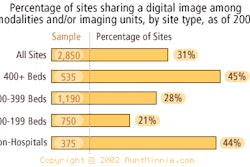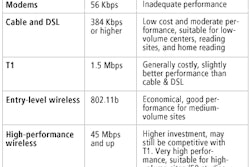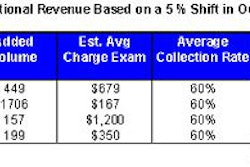Purchasing a full-blown PACS for a small hospital or an independent imaging center can be an expensive proposition. For two healthcare entities with duplicate services in the same geographic area, a joint-venture deal may provide the economies of scale to justify the undertaking.
Marion Regional Imaging in Marion, OH, is the result of a successful integration between two separate imaging centers. Jan Geuy, director of imaging for Marion General Hospital, presented his account of the process at the 2002 American Healthcare Radiology Administrators meeting in New Orleans.
Marion General Hospital, a not-for-profit, 250-bed healthcare facility, carried a full line of imaging services, including x-ray, CT, MRI, ultrasound, nuclear medicine, mammography, and bone-density scanning. It provided 24/7 inpatient coverage, as well as outpatient care seven days a week, and was staffed by three radiologists.
Smith Clinic, located across the street from the hospital, was a multispecialty group practice with 68 physicians. It also boasted a full array of imaging services, thus duplicating the services at Marion General. The clinic was staffed by two radiologists, and the facility offered Monday-through-Saturday outpatient coverage.
When Smith Clinic opened, it was in direct competition with the hospital for imaging business. In fact, the groups often stole personnel from one another, Geuy said, until the administrators at both facilities recognized that a joint venture would be in the best interests of their respective institutions.
In 1999, the organizations began merger discussions. During negotiations, outside consultant Frank Malley of Medical Cost Containment Consultants in Lino Lakes, MN, was hired to create a workflow report for each modality in the facilities. The administrators also asked for a report of projected workflow with a PACS. The groups evaluated the workflow changes, identified the cost-saving opportunities that would be possible with a PACS, and decided to issue a request for proposal (RFP).
Representatives (radiologists, IT personnel, and radiology managers) from both campuses were involved in the selection process. On the basis of a five-year break-even goal, the boards of both groups approved the purchase of a PACS network from Eastman Kodak Health Imaging of Rochester, NY.
Meanwhile, the boards of both organizations agreed to merge outpatient services into a new entity, the Marion Area Health Center. The facility is a for-profit ambulatory surgery facility and freestanding imaging center that has five radiologists and offers complete imaging services.
As part of the joint-venture agreement, each institution agreed to pay for the interface to its current equipment; archiving and data management expenses were shared equally by the organizations. In February 2000, the first server was installed and the modalities began to be connected.
By July of that year, the installation of a mini-PACS connecting the ultrasound and nuclear medicine facilities was begun, and the archive was populated with CT and MRI studies. In September, the facilities conducted CR installations, and by October 2000 the PACS implementation was completed and the system interfaced to a HIS from IDX Systems of Burlington, VT.
"PACS was the commonality in the merger; it happened at the same time and brought the staffs together with a common task," Geuy said.
Hitting their numbers
In its first year of joint-venture operation, imaging services was able to eliminate four full-time equivalents -- a darkroom aide, two couriers, and a file clerk -- for a cost reduction of $150,000. In the second year, two additional FTEs have been cut -- a file clerk and a transcriptionist -- for a cumulative savings of $202,000.
The services also realized savings of $350,000 in film/chemistry, $12,000 in film processor service, and $19,000 in x-ray jackets and supplies the first year. The second year saw a cumulative savings of $434,150 in these same areas.
"The numbers are well on track to meet our five-year, break-even goal," Geuy said.
As a result of the merger, patient volumes have also shifted. In 1999 the hospital conducted 67,000 studies and the clinic performed 41,000. For 2002, the hospital is projected to conduct 46,000 inpatient studies, while the joint-venture center will perform 57,000 outpatient imaging procedures.
"The benefits of PACS have been tremendous. We’ve standardized imaging procedures for both campuses, and reduced film and chemistry costs as well as processor maintenance. We’ve seen a decrease in lost revenue associated with lost films that never got read, reduced the space needed for film storage, and reduced our legal liability associated with original films that got loaned out and were never returned or got lost. Lastly, we’ve decreased exam repeats and increased efficiencies for referring physicians by providing online viewing of images in the physician’s office, emergency department, intensive care unit, operating room, and on the nursing floors," Geuy said.
The facilities are not resting on the success of the current PACS installation. A new imaging center has moved into the area, and the groups are determined to maintain market share. One of the ways they foresee doing this is by providing a more comprehensive range of services, some of which will be PACS-based, to their referring-physician customers.
"We’re adding teleradiology capabilities for our radiologists' home viewing, and voice recognition software to decrease turnaround time for reports. In addition, we’re deploying a Web-based product, and (we’ll) have it installed in a pilot group of orthopedics, neurology, and surgery offices. The greatest benefit of PACS has been the image distribution capability it provides to other clinicians. Our goal is to have a complete deployment of the Web-based viewer in all our referring physicians' offices," Geuy said.
By Jonathan S. BatchelorAuntMinnie.com staff writer
November 14, 2002
Related Reading
HIPAA will squeeze budgets, generate software spending, October 22, 2002
Building a successful new imaging center program, October 8, 2002
The strategic advantages of radiology networks, July 15, 2002
Surviving and thriving in a radiology group merger, June 6, 2002
Joint ventures can help radiology groups survive APCs, July 18, 2001
Copyright © 2002 AuntMinnie.com



















